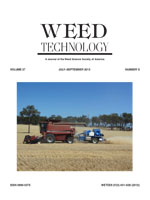Greenhouse studies were conducted in 2012 in Raleigh, NC to determine Carolina redroot control by ten POST herbicides. Paraquat and glufosinate provided the greatest control 14 (73 and 64%, respectively) and 25 d (82 and 68%, respectively) after treatment (DAT), but control declined between 25 and 63 DAT (72 and 59%, respectively). Glyphosate provided minimal control 14 DAT (18%), and control increased from 14 to 25 DAT (46%) and 25 to 63 DAT (69%). Control of Carolina redroot roots and rhizomes (roots/rhizomes) was greatest in plants treated with paraquat (91%), glyphosate (88%), glufosinate (73%), hexazinone (62%), diuron (60%). Nontreated Carolina redroot shoot and root/rhizome dry weight were 8.3 and 7.6 g, respectively. Paraquat, glufosinate, glyphosate, and diuron reduced both shoot and root/rhizome dry weight (3.1 and 0.7 g, 5.1 and 2.7 g, 5.4 and 1.0, 5.7 and 1.6 g, respectively). Hexazinone reduced root/rhizome dry weight (2.7 g). Fomesafen reduced shoot dry weight (6.1 g), but did not reduce root/rhizome dry weight. Paraquat, glufosinate, glyphosate, hexazinone, diuron, and clopyralid treatments resulted in reduced incidence of Carolina redroot flowering and anthesis.
Nomenclature: Clopyralid; diuron; flumioxazin; fomesafen; glufosinate; glyphosate; halosulfuron-methyl; hexazinone; paraquat; sethoxydim; Carolina redroot, Lachnanthes caroliniana (Lam.) Dandy.
En 2012, se realizaron estudios de invernadero en Raleigh, NC para determinar el control de Lachnanthes caroliniana con diez herbicidas POST. Paraquat y glufosinate brindaron el mayor control 14 d (73 y 64%, respectivamente) y 25 d (82 y 68%, respectivamente) después del tratamiento (DAT), pero el control disminuyó entre 25 y 63 DAT (72 y 59%, respectivamente). Glyphosate brindó un control mínimo 14 DAT (18%), y el control incrementó de 14 a 25 DAT (46%) y 25 a 63 DAT (69%). El control de las raíces y rizomas (raíces/rizomas) de L. caroliniana fue mayor en plantas tratadas con paraquat (91%), glyphosate (88%), glufosinate (73%), hexazinone (62%), diuron (60%). El peso seco del tejido aéreo y raíces/rizomas de L. caroliniana sin tratar fue 8.3 y 7.6 g, respectivamente. Paraquat, glufosinate, glyphosate, y diuron redujeron el peso seco del tejido aéreo y raíces/rizomas (3.1 y 0.7 g, 5.1 y 2.7, 5.4 y 1.0, 5.7 y 1.6 g, respectivamente). Hexazinone redujo el peso seco de raíces/rizomas (2.7 g). Fomesafen redujo el peso seco del tejido aéreo (6.1 g), pero no redujo el peso seco de raíces/rizomas. Los tratamientos con paraquat, glufosinate, glyphosate, hexazinone, diuron, y clopyralid resultaron en una incidencia reducida de floración y antesis de L. caroliniana.





